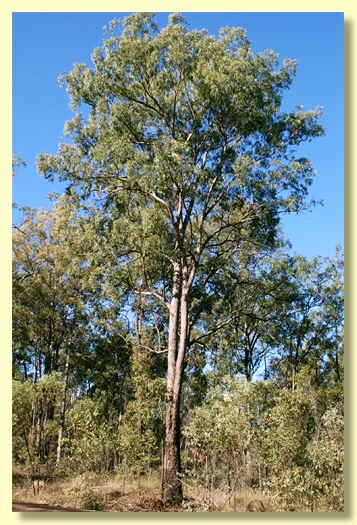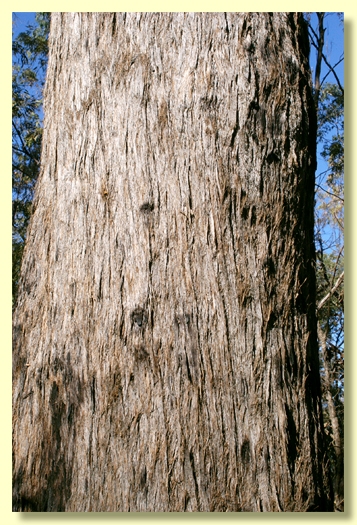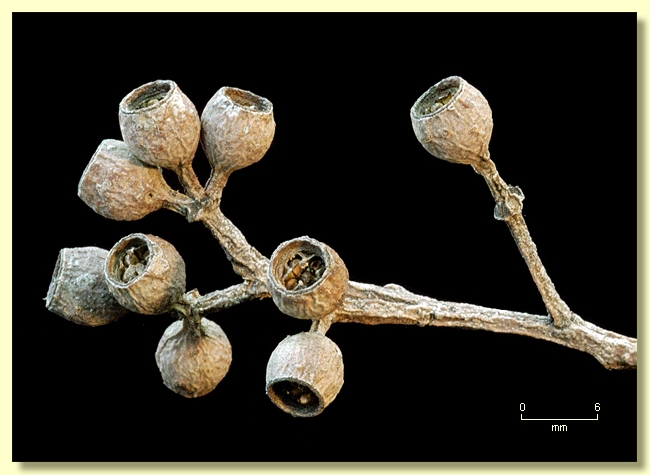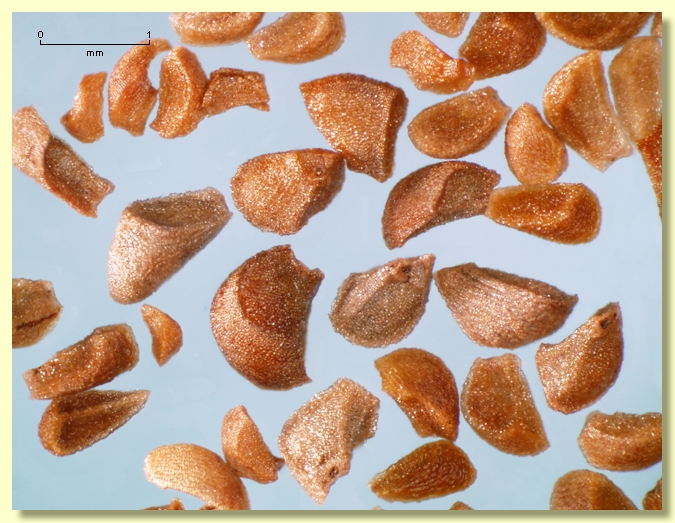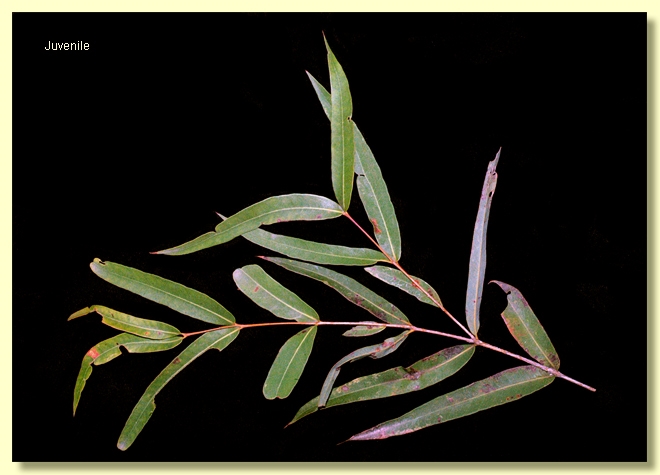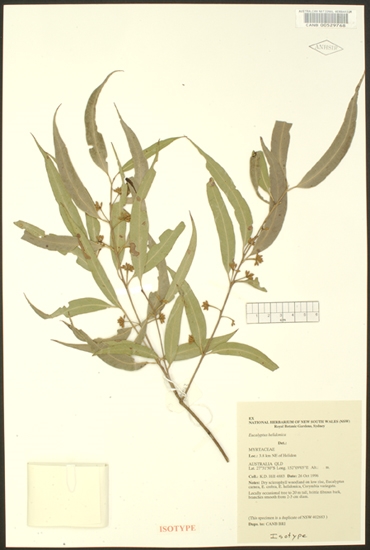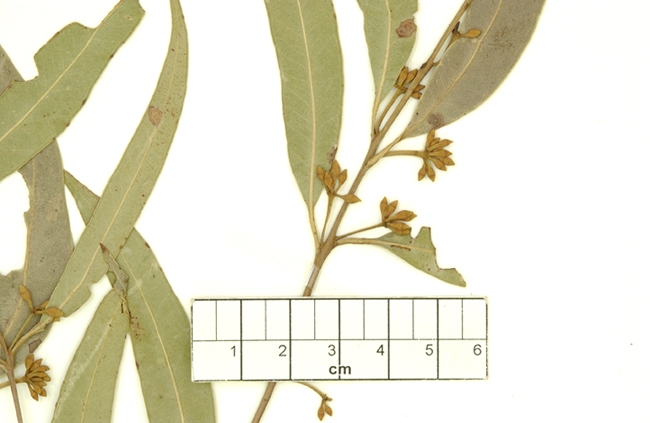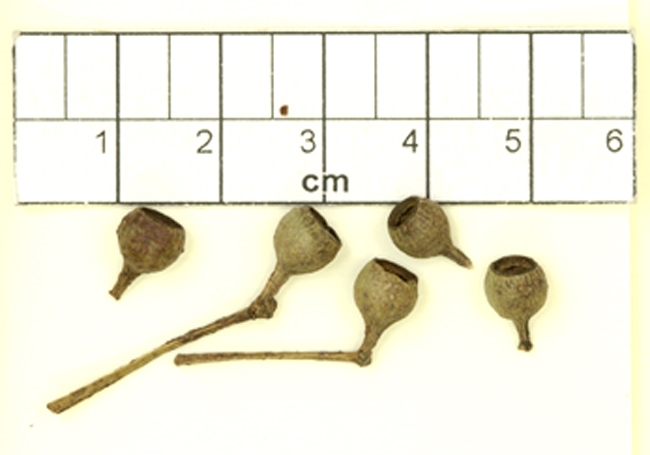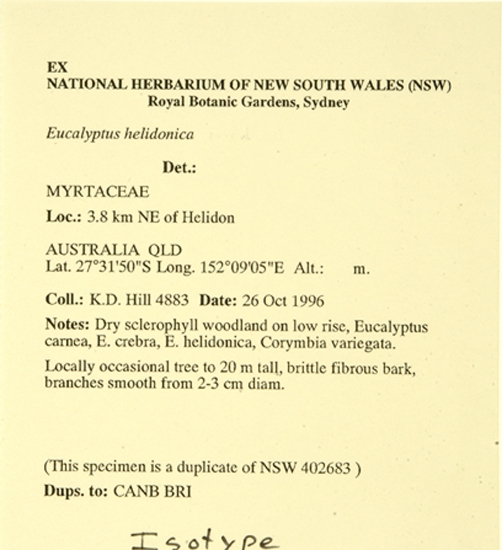Eucalyptus | Eucalyptus | Amentum
Euclid - Online edition
Eucalyptus helidonica
Tree to 20 m tall. Forming a lignotuber.
Bark rough over trunk and branches to 2–3 cm diameter then smooth, rough bark finely fibrous and prickly to touch, grey or grey-brown.
Juvenile growth (coppice or field seedlings to 50 cm): stem rounded in cross-section; juvenile leaves opposite and sessile until saplings 2–3 m tall, linear to narrowly lanceolate, 6–13.5 cm long, 0.7–1.8 cm wide, base amplexicaul, discolorous, dull, green.
Adult leaves alternate, petiole 0.9–2 cm long; blade lanceolate to falcate, 6–15.5 cm long, 0.9–2.5 cm wide, base tapering evenly to petiole, margin entire, apex pointed, discolorous, dull, green, side-veins at ca 45° to midrib, moderately to densely reticulate, intramarginal vein remote from margin, oil glands island.
Inflorescence axillary unbranched, peduncles 1–2.5 cm long, buds usually 11 to ca 15 per umbel, pedicels 0.2–0.5 cm long. Mature buds ovoid, 0.4–0.5 cm long, ca 0.2 cm wide, green to yellow, scar absent, the single operculum shedding at flowering, operculum conical to slightly beaked, stamens irregularly flexed, anthers reniform to cordate, versatile, dorsifixed, dehiscing by confluent slits, style long, locules 4 or 5, the placentae each with 2 vertical ovule rows;. Flowers white.
Fruit pedicellate (pedicels 0.2–0.6 cm long), truncate-globose or barrel-shaped, 0.4–0.6 cm long, 0.4–0.7 cm wide, disc flat and placed just below rim or descending obliquely to vertically, valves 4 or 5, at disc level or ± enclosed.
Seeds brown, 1–1.5 mm long, pyramidal or obliquely pyramidal, dorsal surface smooth, hilum terminal.
Cultivated seedlings (measured at ca node 10): cotyledons reniform; stems rounded in cross-section; leaves opposite and sessile for at least 12 nodes, linear to narrowly lanceolate, 4–8.5 cm long, 0.5–1 cm wide, base amplexicaul at least to node 12, discolorous, dull, green.
Flowering time not known.
A dry sclerophyll forest or woodland tree endemic to Queensland and of restricted distribution in the area immediately around Helidon in the Great Dividing range west of Brisbane. It occurs on sandy soils on sandstone ridges and slopes. Eucalyptus helidonica is distinguished by its rough fibrous prickly bark which extends almost to the smallest branches, discolorous dull leaves in the crown and juvenile growth which has linear-lanceolate leaves sessile and opposite until at least 2 metres tall.
Within its very limited natural range this species can be distinguished from any stringybark species present by inspecting the adult leaves—stringybark species are never distinctly discolorous and always have sparsely reticulate venation whereas the white mahogany E. helidonica will have densely reticulate leaf venation. Care will need to be taken in distinguishing E. helidonica from another mahogany, E. acmenoides, which also occurs in the area. Both species have distinctly discolorous adult leaves. E. acmenoides differs only in the broader ovate to lanceolate juvenile leaves that remain opposite for up to ca 1 metre of coppice growth.
MORE ABOUT WHITE MAHOGANIES
Eucalyptus helidonica: referring to the locality of occurrence near the town of Helidon, Queensland.

